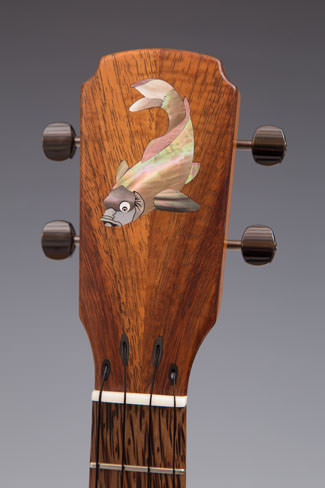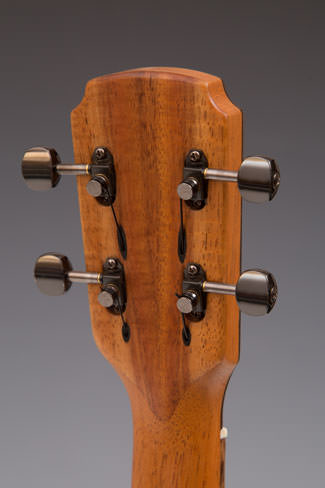
 |
|
#1
|
|||
|
|||
|
I just saw these "stealth" tuners on a ukulele, and wondered if anyone has ever seen them used on a guitar? Sure is an interesting concept. For one thing you wouldn't need the headstock to be angled back anymore. Though I would wonder about drag through the tunnels.
http://www.littleriverukuleles.com/  
|
|
#2
|
|||
|
|||
|
N need to space them so far apart, either. You could have the tuners in one row, with some kind of way to use one key to turn them all, independently.
|
|
#3
|
|||
|
|||
|
Cool.
Great break angle, for more energy transfer. That's what I've read here on AGF as a benefit of slotted heads. |
|
#4
|
||||
|
||||
|
Tony Yamamoto has used those on his Reverie models. They work fine and seem to weigh less, which helps prevent neck diving.
Correction: I now see these are different from what Tony uses, which are normal tuners with the post through the headstock but a slim housing.
__________________
Solo acoustic guitar videos: This Boy is Damaged - Little Watercolor Pictures of Locomotives - Ragamuffin Last edited by rogthefrog; 06-05-2017 at 12:51 AM. |
|
#5
|
|||
|
|||
|
That's a pretty cool idea. First time I've seen it. It definitely frees up real estate for fancy headstock inlays. I wonder what the guides through the headstock are made of. It would take some precise drilling to get the positions of the guide holes on the back of the headstock to be accurately and evenly located because of the angle.
According to this Gotoh web page http://g-gotoh.com/international/product/st31.html, with the tuners that are configured with the post on the same side of the headstock as the gear housing like in the photo above, the maximum tension is only 22 lb. So that would rule out most steel string sets. (See the second note under "Function" referring to Fig. 3 on the web page.) Last edited by Shuksan; 06-04-2017 at 10:01 PM. |
|
#6
|
||||
|
||||
|
Why am I thinking headstock cracks later on down the road at the slightest bump? It does look cool though.
__________________
Barry My SoundCloud page Avalon L-320C, Guild D-120, Martin D-16GT, McIlroy A20, Pellerin SJ CW Cordobas - C5, Fusion 12 Orchestra, C12, Stage Traditional Alvarez AP66SB, Seagull Folk Aria {Johann Logy}: |
|
#7
|
|||
|
|||
|
It looks to me as if the string holes are lines with some sort of plastic, probably to protect the wood from being sawed by the strings and to decrease friction. That so?
__________________
The Bard Rocks Fay OM Sinker Redwood/Tiger Myrtle Sexauer L00 Adk/Magnolia For Sale Hatcher Jumbo Bearclaw/"Bacon" Padauk Goodall Jumbo POC/flamed Mahogany Appollonio 12 POC/Myrtle MJ Franks Resonator, all Australian Blackwood Blackbird "Lucky 13" - carbon fiber '31 National Duolian + many other stringed instruments. |
|
#8
|
|||
|
|||
|
Whoah. Trippy.
|
|
#9
|
||||
|
||||
|
Quote:
__________________
Tom '21 Martin D-18 Standard | '02 Taylor 814c | '18 Taylor 214ceDLX | '18 Taylor 150e-12 | '78 Ibanez Dread (First acoustic) | '08 CA Cargo | '02 Fender Strat American '57 RI My original songs Last edited by Acousticado; 06-05-2017 at 07:27 AM. |
|
#10
|
|||
|
|||
|
Doubt you really have to worry about sawing with unwound nylon strings on a ukulele. I get the lining, but nylon strings are pretty slippery all by themselves.
|
|
#11
|
|||
|
|||
|
Quote:
To answer your question, Steve, yes, I have seen those tuners on some high end custom guitars, but not in that particular configuration. The approach used on this uke is so ingenious I wanted to ogle the headstock photos again, so here we go:   ˙˙˙ My guess is that the builder used this headstock and tuner configuration because it it's less likely to snag on your clothing when you're using it for concealed carry. You know, everyone's sitting around the dinner table, foolishly believing that they're in a safe, hygienic, ukulele-free environment when suddenly - WHAMMO!! - you pull out your concealed carry uke and start serenading them with off-key Hawaiian music.... Hey, man, it's a dangerous world out there. You need to be able to inflict folk music on other people before they get a chance to inflict any on you! Hope this helps... Wade Hampton "Wholly Haole" Miller |
|
#12
|
|||
|
|||
|
Quote:
__________________
'59 Gibson J-45 "Spot" '21 Gibson LG-2 - 50's Reissue '94 Taylor 710 '18 Martin 000-17E "Willie" ‘23 Taylor AD12e-SB '22 Taylor GTe Blacktop '15 Martin 000X1AE https://pandora.app.link/ysqc6ey22hb |
|
#13
|
||||
|
||||
|
Quote:
I think the idea actually originated with banjo, which you may have known already. The Stealth Banjo Company used this approach to avoid a 5th sring tuner. The string was tuned at the headstock but ran down through the neck where it emerged at the 5th fret, with a little wheel serving as the 5th fret nut. 
__________________
Bob DeVellis |
|
#14
|
|||
|
|||
|
I'm thinking on the right headstock those tuners would look good mounted on the front.
__________________
------------------------------------------- Gibson / Flatiron 1996 Prototype "Bruce's Guitar" Gibson 2005 J185ec Gibson 1963 LG0 Gibson 2013 J45 Gibson 2013 LG2 American Eagle Martin 1993 D1 And many more...... Tom Palm Bay, FL |
|
#15
|
|||
|
|||
|
Yes, can be used successfully and it opens great possibilities in headstock design. Not as sturdy though as standard tuners... but here is my attempt:
https://flic.kr/p/PcSLpF |